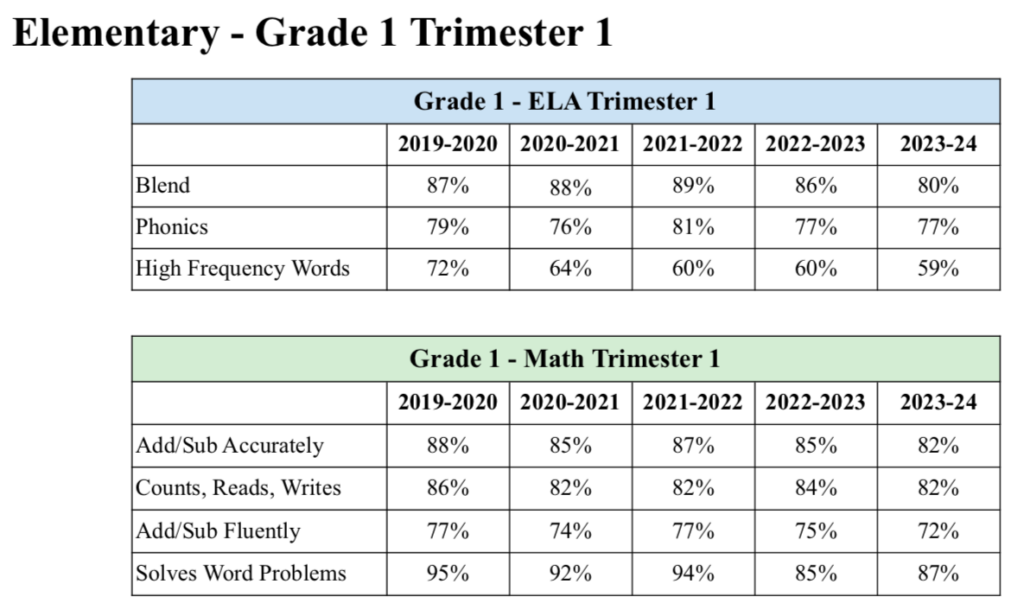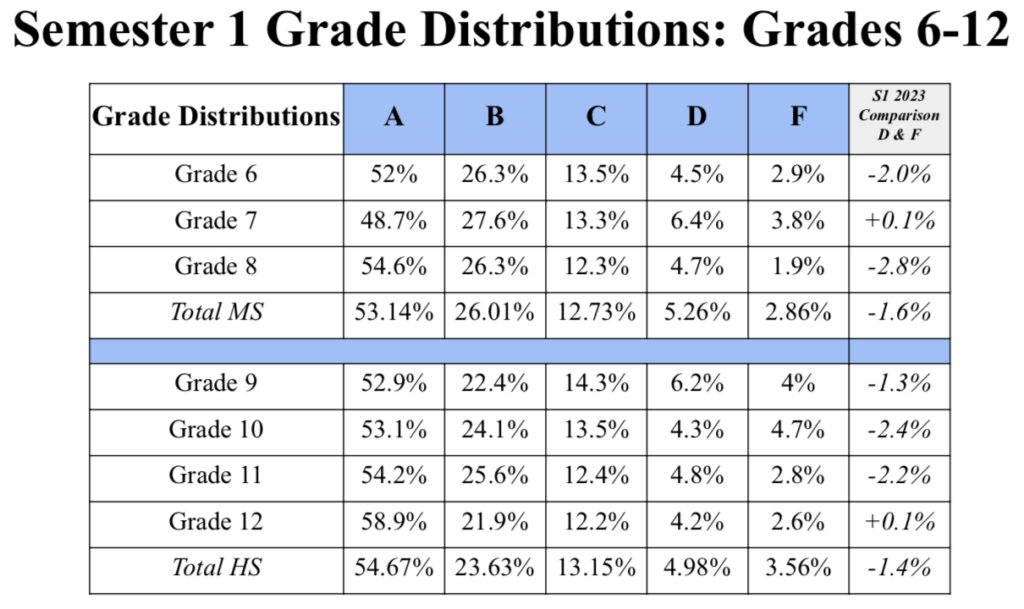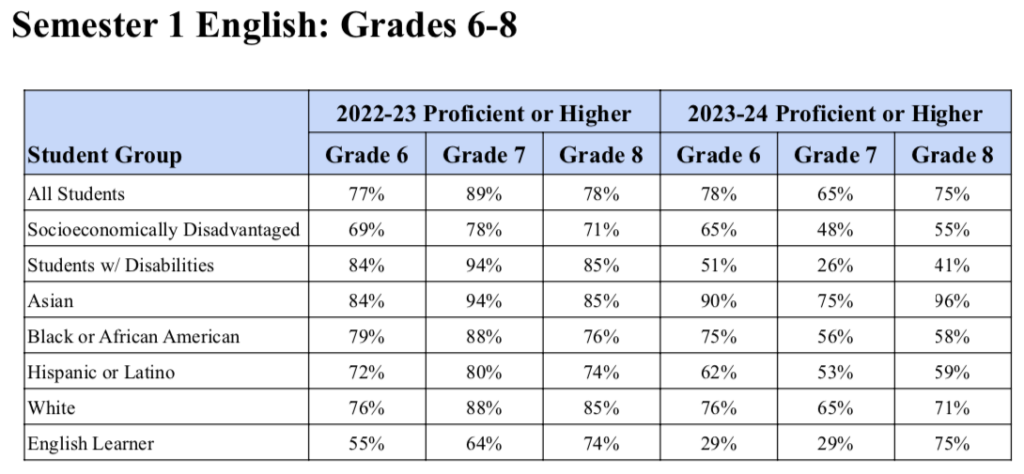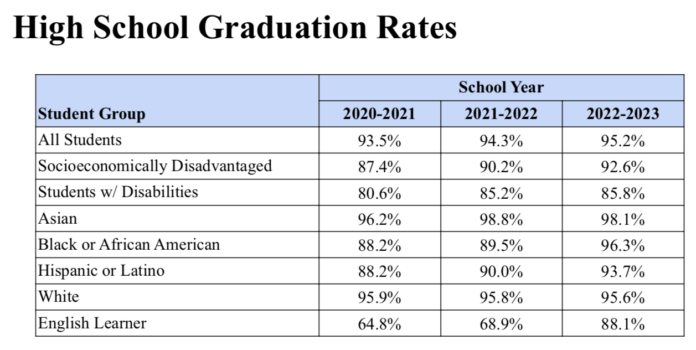Results from first trimester English Language Arts (ELA) and Math assessments show concerning declines in key elementary and middle school classrooms. The report also showed mixed results for high school students’ grade marks, exams and graduation rates. Kenneth Loo, assistant superintendent of student instruction for the Conejo Valley Unified School District (CVUSD), shared the following information.
ELEMENTARY
First-grade students’ performance declined across all metrics compared to first-graders pre-COVID (2019). ELA measured their ability to blend sounds, fluently name letters (phonics) and recognize high-frequency words. Since 2019, among first-graders, blending sounds declined from 87 percent to 80 percent; phonics dropped 79 percent to 77 percent; and high-frequency word recognition dropped a stunning 72 percent to 59 percent.
Noting the poor performance, Loo said, “We just started with our Science of Reading [curriculum] district-wide, so that will certainly be data we pay close attention to, to see the effectiveness in that change of instruction for our students and the benchmarks.”
Student performance in mathematics has also dropped for first-graders every year since 2019. Math assessments measure the ability to add and subtract accurately and fluently, count, read and write numbers, and solve word problems.
Second-graders fared better with ELA, improving 13 percent in phonics over 2019 results while posting smaller gains among the other ELA metrics. In math, second-graders improved 3 percent in solving word problems but dropped 6 percent in being able to understand numbers and place values up to 1,000.
ELA proficiency in third, fourth and fifth grades improved most for Hispanic students, with the biggest gain seen among students who were in fourth grade during 2022-23, improving 32 percent as now-fifth-grade students in 2023-24. All other third-grade groups saw declines between third grade (2022-23) and fourth grade (2023-24), with black and English learner students seeing the largest declines, 6 percent and 9 percent, respectively.
Math scores improved modestly for students between third grade (2022-23) and fourth grade (2023-24), except for black students, who saw a 5 percent drop. Between fourth grade (2022-23) and fifth grade (2023-24), most student groups stayed the same, with the exception of black students, who saw a 16 percent jump, whereas English learner students declined by 5 percent.
MIDDLE SCHOOL
Disastrous English data for grades 6-8 was introduced by Loo with these comments: “We certainly ran into some interesting data here. … We generally say that we saw a decline for our student groups and for as well as all.” He added that teachers “were surprised by the assessment data.”
The data showed sixth and seventh graders in 2022-23 performed significantly lower as seventh and eighth graders in 2023-24, many dropping 20 to 30 percentage points.
Black students’ English proficiency dropped 30 percent between seventh (2022-23) and eighth grade (2023-24).



Hispanic students showed similar declines between sixth and seventh grade, dropping 19 percent, and again between seventh and eighth grade, dropping another 21 percent.
Even Asian students, a group that traditionally tests well, showed a decline between sixth and seventh grade, dropping 9 percent. All student groups together declined 12 percent between sixth and seventh grade. The district acknowledged it has work to do figuring out what happened to the current seventh-grade class.
Math results were not available for middle school because Loo said teachers wanted to pilot a new type of benchmark assessment. The proposed new exam would test all standards in a given course year over multiple assessments taken throughout the year. The goal is to show progress over time rather than a single snapshot of math skills.
HIGH SCHOOL
At the high school level, Loo noted that teachers are giving students fewer D and F marks than in years past. He attributed much of that change to teachers “allowing retakes and redos, accepting late work without penalty, removing extra credit and using a minimum grade of 50 percent.” In other words, grading standards have changed, making it more difficult to fall below a C.
Eric Bergman, principal at Thousand Oaks High School, pointed out that the data showed ninth-graders struggling the most with D’s and F’s. He told the Board, “This tells me to target ninth-grade students early,” with “study skills and strategies in classes.”
In better news, small gains were made across all groups in graduation rates from the class of 2021 at 93.5 percent to the most recent class of 2023 at 95.2 percent. The biggest increases were among black students (up 8.1 percent), Hispanic students (up 5.5 percent), and English learners (up 23.3 percent).
However, the percentage of students taking Advanced Placement exams and achieving a passing score of 3 or better has been fitful, declining from 78 percent in 2019-20 to 70 percent in 2020-21, rebounding to 78 percent the following year in 2021-22, then declining this past year to 76 percent in 2022-23.
International Baccalaureate testing (available only at Newbury Park High School) pass rates had held consistent at 98 percent from 2019 to 2022, but dropped to 95 percent in 2022-23.

